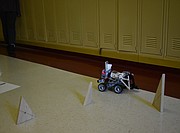Troy robotics class puts creativity, skills to the test
After weeks of preparation, the robotics class at Troy High School got the chance March 23 to test out their robotic drone creations.
Though made from Lego kits, each team’s robot was unique, built by the novices based on a series of expectations for the final obstacle course.
Using phones and two-way video chat applications such as Skype, Facetime or Google Hangouts, one member of each team sat in the classroom and attempted to navigate the robot drone through obstacles a few feet away and out of sight in the hallway.
The drones were controlled from a separate phone using an application with on screen sliders that control things such as speed, direction and moving the shovels on the fronts or backs of the robots.
For some teams, it was difficult to contain their reactions as they watched in the hallway, but there was no giving away hints to the drivers in the other room.
“I liked the driving part,” said MacKenzie Tallmadge, who was the first driver to successfully navigate the course, in part because of her care and patience.
While the class has built other robotic devices, including one they had to program to go around corners, this was the first time they had to build something without any instructions or designs to go off of, Tallmadge said.
There were a few bumps along the way for all the teams.
Driver Steven Stinson admitted he misunderstood the initial instructions, and thought the goal was to knock over — rather than drive around — the small wooden obstacles. Given that miscommunication, his first attempt was more of a success than it first appeared.
Tallmadge and teammate Madason Anspach agreed that the exercise helped them learn a few things about working closely with a team, something of which neither of them are big fans.
“I am not good in group work,” Anspach said. “But I managed to actually stick with them instead of going to the teacher and complaining.”
Their third team member, Owen Cook, said he felt the project also helped them learn to adapt to a lack of resources and information.
“We didn’t know how to build it or what we were supposed to build,” Cook said. “We winged it.”
They weren’t even allowed to look at images of similar robots on the Internet as inspiration, Anspach said. “We just saw what we had to do, and built it with that.”
In the weeks leading up to the obstacle course, the team had iterations of their robotic drone fall apart under the weight of the drive system and other design flaws to figure out.
But, when the final day came, theirs was one of the few that experienced no mechanical malfunctions.
“Our robot isn’t the prettiest, but it’s worked the best so far,” Anspach said.
Along with designing from scratch, the class also got to learn a bit about engineering in the field. The day of the obstacle course, several teams had to make field-expedient adjustments to phone cradles and last minute repairs to drive systems.
“They did well,” said teacher Neil Newton. “There was a lot of problem solving to be had, that’s for sure.”
“Just the creativity and the problem solving that comes from a class like this is just awesome,” he said. “And it’s going to be very beneficial for the kids, especially as we move into the future.”
Newton noted the increasing roles that robots are expected to have in society.
“And somebody’s going to have to build them and take care of them and program them and design them,” he said. “So, yeah, it’s good skills to have.”
The class is unusual in that students from freshmen to seniors are all in the same class together, Newton said. Yet, for a subject with so many novel elements, it’s rare that an upper class student has any serious knowledge advantage over a younger student.
“We do get into some gear ratios and things like that, but they would have already had that knowledge in junior high,” Newton said.
Newton said that he has enjoyed working with the students and teaching them in a subject where they get to mix creativity with serious problem solving skills.
“It’s just always fun to watch them grow,” Newton said. “Anytime you have students, it’s fun to watch them grow and to just be passionate about something.”



